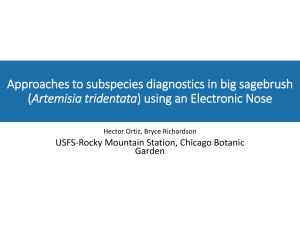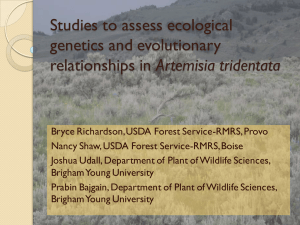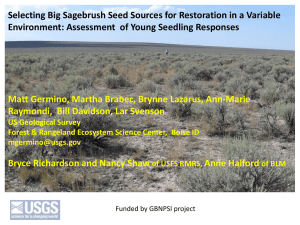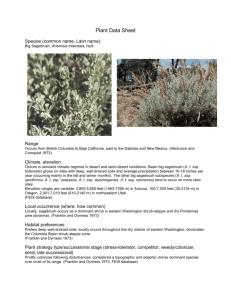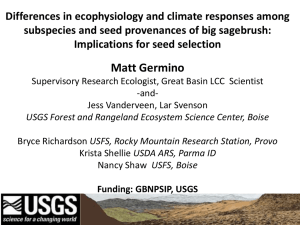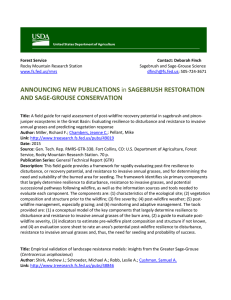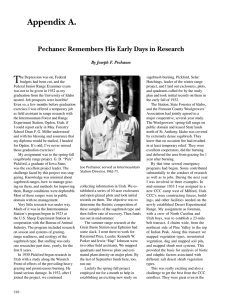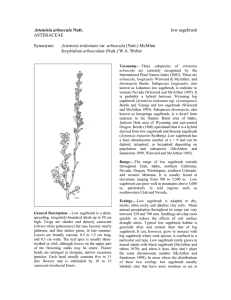Phylogenetics of big sagebrush Bryce Richardson , Joshua Udall
advertisement
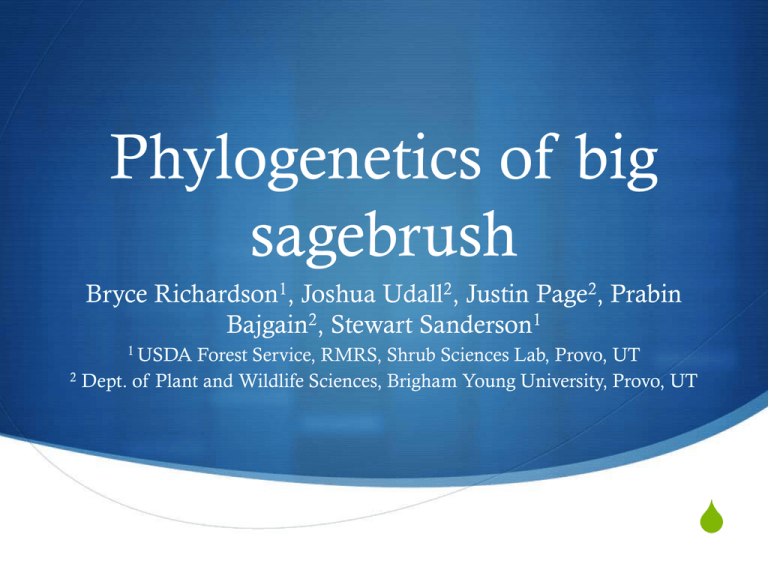
Phylogenetics of big sagebrush Bryce Richardson1, Joshua Udall2, Justin Page2, Prabin Bajgain2, Stewart Sanderson1 1 USDA Forest Service, RMRS, Shrub Sciences Lab, Provo, UT 2 Dept. of Plant and Wildlife Sciences, Brigham Young University, Provo, UT S Big sagebrush morphological variation vaseyana(2X) 4X 4X tridentata(2X) Polyploid formation Genetics review of big sagebrush S Diploid ssp tridentata and vaseyana occupy different ecotypes S Hybridize in ecotones, diploid hybrids are adapted to narrow ecotones, but not parental ecotypes (McArthur et al. 1981, 1988, Wang et al. 1997) S Polyploids (tetraploids), including ssp. wyomingensis, are probably more abundant on the landscape than diploids S Approximately half of all sampled plants were tetraploids (McArthur and Sanderson 1999) Objectives S Elucidate phylogenetic relationships among subspecies S Discern the origins of subspecies wyomingensis and other tetraploids S Compare morphological characteristics to phylogenetic relationships Methods S Sequences obtained through next-generation transcriptome sequencing (Bajgain et al. 2011) S 25 putative genes associated with secondary metabolite pathway were sequenced (~12,000 bp of data) S 329 samples sequenced from 49 collection sites (7 samples per site) S Phylogenetic analyses: Bayesian coalescence and neighbor-net network S Genome size:flow cytometery (3 individual per site) Regional races? A. tridentata polyploid complex Artemisia nova? Summary S Big sagebrush represents a polyploid complex in which tetraploids, including wyomingensis, have formed numerous times S Tetraploids appear to be of local or regional origins S Under a genetic and evolutionary context, wyomingensis is not a subspecies S Morphology and UV fluorescence is diagnostic for diploids, but not for tetraploids Future research S Information can be used to define common garden seed sources for analyses S What are the geographic distributions of tetraploids lineages? S Are these lineages adapted to particular environments? S Is there interspecific hybridization with A. nova or other sagebrush species? S How frequent do polyploids develop? Is it in response to environmental stimuli? E-nose technology Applications of E-nose technology for the sagebrushes S E-nose (Electronic nose) is a device that can differentiate different volatile chemicals S Polymer coated membranes react uniquely to different volatiles S An electrical current is past over the membrane. Changes in conductance, caused by the way the polymer reacts to the volatile are recorded E-noses for the seed industry S Could rapidly detect aromatic differences between big sagebrush or between sagebrush species S Works on seeds or leaves S A means of certifying seed to subspecies or ecotype? Preliminary results Taxa Taxa Seed Volatile QF Leaf Volatile QF A.t. tridentata A.t. vaseyana 2.83 3.259 tridentata wyomingensis 1.207 2.307 vaseyana wyomingensis 2.291 2.065 A. arbuscula A. nova - 11.035 A. arbuscula A. tridentata ssp. - 5.019-6.678 A. nova A. tridentata ssp - 4.756-5.861 Values > 2.0 are significantly different (p < 0.05) Acknowledgements S Big sagebrush: Prabin Bajgain, Justin Page, Stewart Sanderson, numerous agency volunteers S E-nose technology: A. Dan Wilson S Funding: GBNPSIP, National Fire Plant, Western Forest Transcriptome Survey
